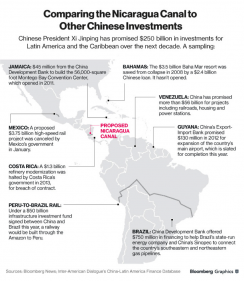Initial Nicaraguan Actions
In early 2013, HKND proposed the Nicaraguan Canal Project (“the Project”) and presented economic projections to the Nicaraguan government. A bill to approve the Project was quickly passed through the Nicaraguan National Assembly, but on strict “party lines.” From the onset, the United States and many other countries have believed the Chinese government is behind the Project, but the Chinese have vehemently denied such claims.
There are several speculations for why Ortega is pushing the Project:
- It is a “power grab” for additional land
- The Project was introduced prior to the most recent elections
- Ortega candidly believes the Project will benefit Nicaragua’s economy
- The canal will strengthen Nicaragua’s political and economic status in the world
Political Opposition in Nicaragua
On August 7th, 2013, political opposition in Nicaragua filed a Supreme Court challenge claiming the canal violated 15 parts of the Constitution – this gesture was likely a symbolic one, for, with the Sandinistas in power, there is little chance the Project will be revoked.
In addition, the former Vice President has also written a manifesto accusing Ortega of violating national sovereignty for his personal gain.
Since the announcement, there have been many public protests, some of which have fostered violence between the general public and the police force. Estimates indicate that more than 15,000 people have taken part in such protests.
Autonomous Region
One of the most contentious political controversies surrounding the Project is the proposed removal of land from thousands of inhabitants of the autonomous regions (i.e., in order to build the canal through their land). In coordination with the bill, officials passed Law 840, which amended the Constitution, enabling the government to reclaim land from the two autonomous tribes, the Rama and the Creole. Essentially, this move put HKND “above the law,” and exhibited the lengths to which Ortega would go in pursuit of a canal.
Nicaragua is a member of a group called the United Nations Declaration on the Rights of Indigenous Peoples, which states, “free, prior and informed consent” is required for “the approval of any project affecting [indigenous peoples’] lands or territories and other resources, particularly in connection with the development, utilization or exploitation of mineral, water or other resources,” for “adopting and implementing legislative or administrative measures that may affect them,” or for any “relocation.” The Inter-American Court of Human Rights has reviewed cases regarding this issue, and acknowledges the validity of the above statements. Since the law was passed, the IACH has been investigating the Nicaraguan government.
The video below gives a brief glimpse of the opinions of the Bangkukuk community, a group of Rama people.
U.S. Concern
In 2013, the Deputy Secretary of Commerce, Bruce Andrews, visited Nicaragua and said the United States would assist the Project if the private sector showed interest. He also claimed that if Nicaragua sought loans via the Inter-American Development Bank, the United States would be compelled to oppose. Since 2013, however, the United States has not taken any major steps to halt construction – many blame the United States’ unclear Latin American policy and its focus on the Middle East.
By staying largely uninvolved in the Project, the United States may ultimately sacrifice its Latin American dominance, which is already slipping away. In recent years, the Chinese have increased China-South American trade from $12 billion to $289 billion. While the Chinese government claims it is not directly involved with the Project, the canal could benefit them greatly. The canal would significantly shorten the number of days required to transport supplies from China to the Caribbean, further impeding United States trade territory. Moreover, the canal will also be deep enough for Chinese submarines.



